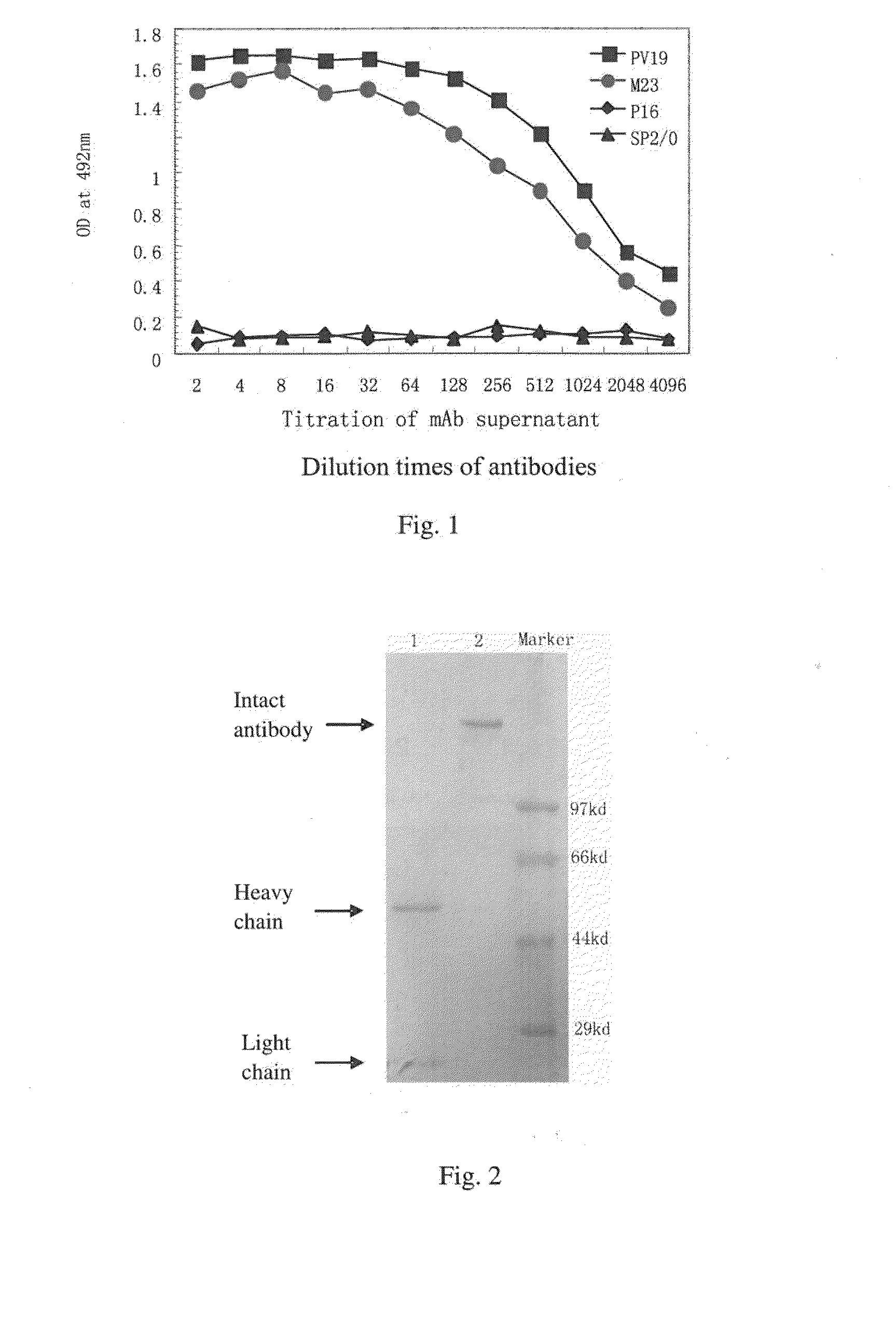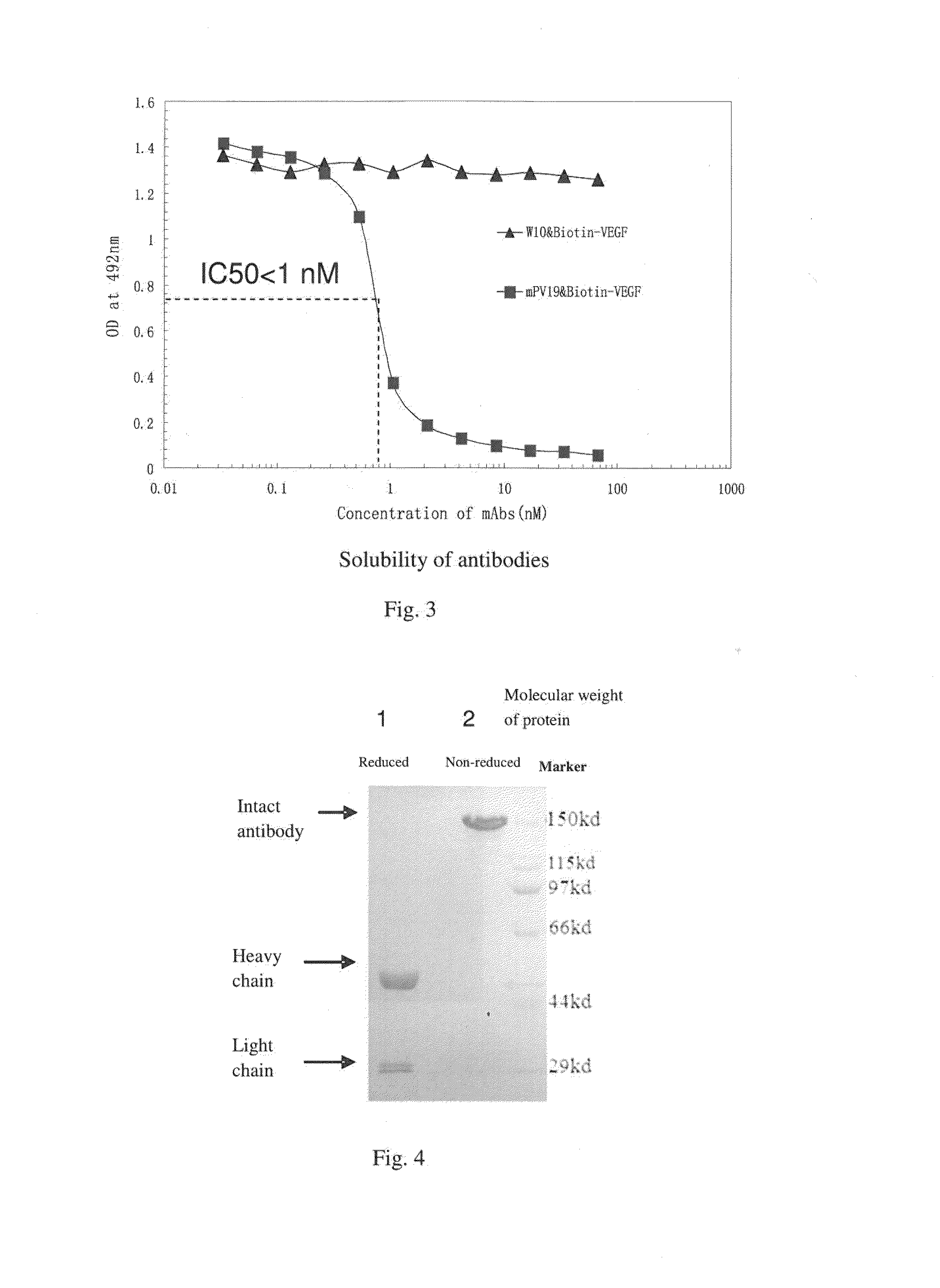Monoclonal antibody for antagonizing and inhibiting binding of vascular endothelial cell growth factor and its receptor, and coding sequence and use thereof
a vascular endothelial cell and growth factor technology, applied in the field of biotechnology, can solve the problems of inability to neutralize vegf entirely, prolong the overall survival, and inhibit tumor growth, and achieve the effect of reducing the effect of the pharmaceutical composition
- Summary
- Abstract
- Description
- Claims
- Application Information
AI Technical Summary
Benefits of technology
Problems solved by technology
Method used
Image
Examples
example 1
Production and Identification of Mouse Hybridoma Cell Lines Secreting Anti-Vascular Endothelial Growth Factor Antibody
[0057]Step 1. Production of Recombinant Human VEGF165 Protein (Immunogen Preparation)
[0058]DNA fragments encoding human VEGF165 protein was obtained by PCR using human lung tissue cell cDNA as the template. After being verified by sequencing, a segment was cut out by restriction endonuclease digestion and cloned into pPic9K, a yeast expression vector (Invitrogen Corporation), thus yielding recombinant expression plasmid pPic9K-VEGF165. This plasmid was then introduced into yeast cell Pichia pastoris. After fermentation and inducible expression, followed by protein separation and purification, recombinant human VEGF165 protein with greater than 95% purity was obtained.
[0059]Step 2. Immunization in Mice
[0060]a. Balb / c mice were immunized with human VEGF165 protein (100 μl / mouse, 10 μg VEGF165 protein in total) mixed with the Freund's complete adjuvant by multi-point su...
example 2
Production and Purification of Mouse Anti-Human VEGF Monoclonal Antibody (PV19)
[0068]Mouse anti-human VEGF monoclonal antibody (PV19) was purified from cell culture supernatants by using an affinity chromatography
[0069]The purification steps are as follows:
[0070]The PV19 hybridoma cells, after being amplified, were inoculated in 200 ml serum-free 1640 medium and cultured at 37° C. for 5 days. Then, the culture supernatants were collected and filtered through a 0.45 μm filtration membrane, before being loaded to an affinity chromatography column containing Protein G-Sepharose Fast Flow (purchased from General Electric). The chromatography column was first subjected to washing with PBS to remove nonspecific proteins; followed by elution of adsorbed PV19 antibody protein with a low pH (2.7-3.0) glycine (0.1M) solution. The elute protein was then adjusted to pH 7.0 with 1 mM Tris (pH 8.5-9.0), dialyzed against PBS (10 times volume of the elute) for 12-16 hours (changing solution 2-3 tim...
example 3
Determination of Biological Activity of Murine PV19 Monoclonal Antibody: Inhibition of the Binding of VEGF to VEGF-R by PV19 Monoclonal Antibody
[0072]One method of determining the biological activity of murine PV19 monoclonal antibody is to use a competitive ELISA to probe the inhibition of the binding of VEGF to VEGF R by PV19 antibody.
[0073]The principle and process of this competitive ELISA method are as follows:
[0074]First, a fixed amount of biotin-labeled human VEGF165 protein is mixed with serial dilutions of PV19 antibody. The mixtures are then transferred to a 96-well plate pre-coated with soluble VEGF receptor proteins (such as soluble VEGFR1 protein). After incubation and washing, enzyme-labeled Avidin (such as horseradish peroxidase-labeled Avidin) is added into the plate. After another incubation and washing, substrate is added and OD value is measured.
[0075]Specifically, the competitive ELISA are as follows:
[0076]1) Coat 96-well plate with soluble human VEGFR1 protein (...
PUM
| Property | Measurement | Unit |
|---|---|---|
| concentration | aaaaa | aaaaa |
| concentration | aaaaa | aaaaa |
| pH | aaaaa | aaaaa |
Abstract
Description
Claims
Application Information
 Login to View More
Login to View More - R&D
- Intellectual Property
- Life Sciences
- Materials
- Tech Scout
- Unparalleled Data Quality
- Higher Quality Content
- 60% Fewer Hallucinations
Browse by: Latest US Patents, China's latest patents, Technical Efficacy Thesaurus, Application Domain, Technology Topic, Popular Technical Reports.
© 2025 PatSnap. All rights reserved.Legal|Privacy policy|Modern Slavery Act Transparency Statement|Sitemap|About US| Contact US: help@patsnap.com



